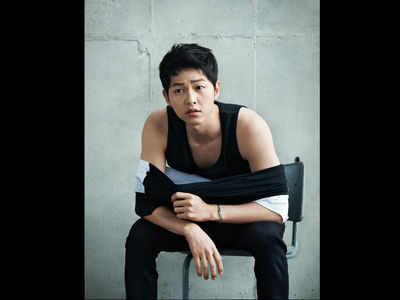- News
- Food to lingo, India goes on a K-trip
This story is from November 27, 2016
Food to lingo, India goes on a K-trip
Indians — especially the youth — are learning Korean, eating kimchi and travelling to Seoul to sample the life shown on their favourite TV dramas, and films

Indians — especially the youth — are learning Korean, eating kimchi and travelling to Seoul to sample the life shown on their favourite TV dramas, and films
Indians — especially the youth — are learning Korean, eating kimchi and travelling to Seoul to sample the life shown on their favourite TV dramas, and films
W-Two Worlds. BigBang. 2 PM. DOTS. EXO. BTS. I’m sorry to have to break this to you but if you aren’t familiar with the words, you are so, so yesterday. The Korean wave or hallyu, which includes everything from boy bands to TV shows, hit desi shores some years ago and hit it with all the force of a gale.When that gale receded, it left behind a sizeable crater constituency of fans across India, metros/B-towns/one-dog towns all included.
You really want the backstory? The South Korean entertainment industry is worth megabucks and is aiming for and achieving world domination. Forbes reported that boy band Bigbang took home $44 million in 2015. Compare this with the $33.5 million collected by today’s highest-paid American all-male arena pop group, Maroon 5. Over the last decade, K-pop and K-dramas, as well as their movies, have unleashed a tsunami of growth and popularity in India, and the numbers of avid fans continue to grow exponentially.
And here’s the thing. This parallel universe grew to adult size and hunkered down amidst us, quietly, without fanfare or fuss. It’s like that narrow house in one of the Harry Potter books, which stood invisible to all except those who sought it.
 Hallyu bol! A still from The Legend of the Blue Sea, a popular drama
Hallyu bol! A still from The Legend of the Blue Sea, a popular drama
The northeast of course has had a long history of being Seoul-stirred. In the south, a Tamil network translates and telecasts K-dramas. The Korean zombie flick Train to Busan, which was dubbed in Hindi too, did brisk business last month, and quite a few Korean films have been remade into Hindi and Tamil films. That ‘loosely inspired’ list includes Prem Ratan Dhan Payo from Masquerade; Ek Villain from I Saw The Devil; Zinda from Oldboy; Murder 2 from The Chaser; Jazbaa from Seven Days; and in Tamil, Yaamirukka Bayamey from The Quiet Family and Jigarthanda from A Dirty Carnival.
Internet groups with a monstrous member list bind these K-fans together, as do Korean Culture Centre meets across cities where K-fans meet with all the fervour of Masons attending a Lodge meeting.
Throw the K-word at any hallyu fan and watch the genie emerge from the bottle. They will tell you about how they have learned the language so that they can watch K-dramas without resorting to subtitles; how they sing along to their favourite songs; how words like waeyo (why), hajima (don’t), mianhae (sorry), aigoo (best translated as aiyyo) are now part of their daily vocabulary, how they collect photos of swoon-worthy actors like Song Joong-ki and Lee Min Ho, and how they can argue forever over the superiority of K-pop bands like Girl’s Generation, EXO, SHINee, Super Junior.
“A friend and I talk to each other in class using Korean words. That way no one else can understand us,” says Nina Karun, a student.
While the demographic of the K-constituency is largely the teen and mid-twenties age group, and almost overwhelmingly female, there are plenty of older people who rush home after work to binge-watch the latest season of K-dramas. As for its addictive properties, few have walked into the K-world and left it disillusioned. Or bored.
“I used to work in a game publishing company. Then K-pop and K-dramas turned my professional life around,” says Sanjay Ramjhi. After visiting South Korea to see what he had seen on TV, Ramjhi went on to learn Korean and is now an interpreter from Korean to English and Tamil, in Chennai.
Jennifer Sarto, business executive, met a similar fate. She sought and got a job with a well-known Korean MNC. “Hallyu took me to South Korea, changed my life.”
Talk inevitably moves to the food and you hit the mother lode there, along with a list of must-try recommendations. The top favourites include bulgogi (a marinated beef dish), dak galbi (chicken) and haemultang (seafood stew) for non-vegetarians, dolsot bibimbap (mixed rice and vegetables) and japchae (glass noodles) for the vegetarians. And of course, that ubiquitous favourite, kimchi (spicy, pickled vegetables) that goes with everything.
“I have discovered Korean food through K-dramas and I love it,” exclaims Priyanka Subramaniam, who works for an NGO, and is constantly on the lookout for Korean ingredients. When it comes to fashion, the impact is relatively subdued, possibly because their styles don’t blend with Indian sensibilities.
Let’s not, for a moment, underestimate the power of word-of-mouth publicity in the spread of hallyu. Every individual was introduced to K-pop and K-drama through a friend and every individual has made it a point to pass it forward! But please don’t ask any K-fan about Kim Jong-un. It’s not that Korea, see?
W-Two Worlds. BigBang. 2 PM. DOTS. EXO. BTS. I’m sorry to have to break this to you but if you aren’t familiar with the words, you are so, so yesterday. The Korean wave or hallyu, which includes everything from boy bands to TV shows, hit desi shores some years ago and hit it with all the force of a gale.When that gale receded, it left behind a sizeable crater constituency of fans across India, metros/B-towns/one-dog towns all included.
You really want the backstory? The South Korean entertainment industry is worth megabucks and is aiming for and achieving world domination. Forbes reported that boy band Bigbang took home $44 million in 2015. Compare this with the $33.5 million collected by today’s highest-paid American all-male arena pop group, Maroon 5. Over the last decade, K-pop and K-dramas, as well as their movies, have unleashed a tsunami of growth and popularity in India, and the numbers of avid fans continue to grow exponentially.
And here’s the thing. This parallel universe grew to adult size and hunkered down amidst us, quietly, without fanfare or fuss. It’s like that narrow house in one of the Harry Potter books, which stood invisible to all except those who sought it.

The northeast of course has had a long history of being Seoul-stirred. In the south, a Tamil network translates and telecasts K-dramas. The Korean zombie flick Train to Busan, which was dubbed in Hindi too, did brisk business last month, and quite a few Korean films have been remade into Hindi and Tamil films. That ‘loosely inspired’ list includes Prem Ratan Dhan Payo from Masquerade; Ek Villain from I Saw The Devil; Zinda from Oldboy; Murder 2 from The Chaser; Jazbaa from Seven Days; and in Tamil, Yaamirukka Bayamey from The Quiet Family and Jigarthanda from A Dirty Carnival.
Internet groups with a monstrous member list bind these K-fans together, as do Korean Culture Centre meets across cities where K-fans meet with all the fervour of Masons attending a Lodge meeting.
Throw the K-word at any hallyu fan and watch the genie emerge from the bottle. They will tell you about how they have learned the language so that they can watch K-dramas without resorting to subtitles; how they sing along to their favourite songs; how words like waeyo (why), hajima (don’t), mianhae (sorry), aigoo (best translated as aiyyo) are now part of their daily vocabulary, how they collect photos of swoon-worthy actors like Song Joong-ki and Lee Min Ho, and how they can argue forever over the superiority of K-pop bands like Girl’s Generation, EXO, SHINee, Super Junior.
“A friend and I talk to each other in class using Korean words. That way no one else can understand us,” says Nina Karun, a student.
While the demographic of the K-constituency is largely the teen and mid-twenties age group, and almost overwhelmingly female, there are plenty of older people who rush home after work to binge-watch the latest season of K-dramas. As for its addictive properties, few have walked into the K-world and left it disillusioned. Or bored.
“I used to work in a game publishing company. Then K-pop and K-dramas turned my professional life around,” says Sanjay Ramjhi. After visiting South Korea to see what he had seen on TV, Ramjhi went on to learn Korean and is now an interpreter from Korean to English and Tamil, in Chennai.
Jennifer Sarto, business executive, met a similar fate. She sought and got a job with a well-known Korean MNC. “Hallyu took me to South Korea, changed my life.”
Talk inevitably moves to the food and you hit the mother lode there, along with a list of must-try recommendations. The top favourites include bulgogi (a marinated beef dish), dak galbi (chicken) and haemultang (seafood stew) for non-vegetarians, dolsot bibimbap (mixed rice and vegetables) and japchae (glass noodles) for the vegetarians. And of course, that ubiquitous favourite, kimchi (spicy, pickled vegetables) that goes with everything.
“I have discovered Korean food through K-dramas and I love it,” exclaims Priyanka Subramaniam, who works for an NGO, and is constantly on the lookout for Korean ingredients. When it comes to fashion, the impact is relatively subdued, possibly because their styles don’t blend with Indian sensibilities.
Let’s not, for a moment, underestimate the power of word-of-mouth publicity in the spread of hallyu. Every individual was introduced to K-pop and K-drama through a friend and every individual has made it a point to pass it forward! But please don’t ask any K-fan about Kim Jong-un. It’s not that Korea, see?
End of Article
FOLLOW US ON SOCIAL MEDIA
